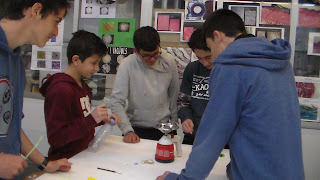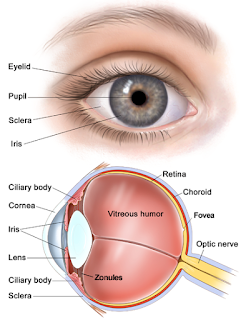Today we have built a submarine to work on the concept of buoyancy.
Did you know that, in early times, submarines were often powered by hand because boat engines had not been invented yet?
4/21/2016
4/20/2016
The sheep eye
The human eye is an organ that reacts to light and
has several purposes. As a sense organ, the mammalian eye allows for
vision.
Today we have learned about the main parts of the human eye.
First, we have noted those parts in a drawing of a section of the eye.
Then
we have defined the specific function of each part. For example, we have
learned that specialized cells located on the retina, called rods and cones cells,
allow for conscious light perception and vision including color differentiation
and the perception of depth.
The human eye can distinguish about ¡¡¡10 million colors!!!
The eye is not shaped like a perfect sphere. The smaller frontal unit,
transparent and more curved, called the cornea is linked to
the larger white unit called the sclera.
The iris is the colored circular structure concentrically
surrounding the center of the eye, the pupil, which appears to be
black. The size of the pupil, which controls the amount of light entering the
eye, is adjusted by the muscles of the iris.
Light enters the eye
through the cornea, then the pupil and then
through the lenscontrolled by cilliary muscles. Light
falling on the light-sensitive cells of the retina is converted into electrical
signals that are carried to the brain by the optic nerves.
Did you know that a device known as an ophthalmoscope is
used to see inside the eye?
Labels:
Biology & Geology
Location:
Igualada, Barcelona, España
4/07/2016
The human eye
The human eye is an organ that reacts to light and has several purposes. As a sense
organ, the mammalian eye allows
for vision.
Today we have learned about the main parts of the human eye.
First, we
have noted those parts in a drawing of a section of the eye. Then we have
defined the specific function of each part. For example, we have learned that
specialized cells located on the retina,
called rods and cones cells, allow for conscious light
perception and vision including color differentiation and the perception of
depth.
The human eye can
distinguish about ¡¡¡10 million colors!!!
The eye is not shaped
like a perfect sphere. The smaller frontal unit, transparent and more curved,
called the cornea is linked to the
larger white unit called the sclera.
The iris is the colored circular structure
concentrically surrounding the center of the eye, the pupil, which appears to be black. The size of the pupil, which
controls the amount of light entering the eye, is adjusted by the muscles of the iris.
With all this information, we have made
a mural.
In the next practice at the lab, we will use that information to dissect
a sheep's eye and try to understand how this important sensory organ works. We expect new emotions!
Did you know that a device known as an ophthalmoscope is used to see inside the eye?
Labels:
Biology & Geology
4/06/2016
Wave Phenomena: Reflection and Refraction
In the video below, you can find an explanation for the phenomena of reflection and refraction in waves.
Courtesy of our students of 2n Batxillerat B.
Snell's law:
Courtesy of our students of 2n Batxillerat B.
Snell's law:
Archimedes' principle betting game
Today we have been working on the consolidation of the Archimedes' principle. We have worked with a betting game to revise all the concepts to study.
4/05/2016
Taste sense
Can a taste be identified by any part of the tongue?
Our sense of taste is the sense that enables us
to recognize flavors, and this task is helped by our sense of smell. Therefore, when we have a cold, food seems as
if it has less flavor.
Basically, as humans, we are able to identify
four flavors: salty, sour, sweet and bitter.
The
taste that we obtain when we eat something is a combination of all of these,
perceived through the taste buds that cover the surface of our tongue.
However,
the taste buds are specialized in detecting specific flavors, and they cannot
identify any other flavors that we consume.
So, can a taste be identified by any
part of the tongue or is it only identified by a certain area of the tongue?
In pairs, we are prepared four concentrated solutions: one with sugar, one with salt, one with lemon juice and one with instant coffee, adding a spoonful of each to four different glasses.
Then, students have put each other a drop on a specific point on his/her classmate's tongue without them knowing the place or the substance used. Afterwards, they have marked the position on the drawing of the tongue.
Finally, we have tried to prove our initial hypothesis. Taste sense is certainly dependent of different gustative receptor cells able to percebre the different chemical substances which contain food.
Conlusion: Our hypothesis was confirmed. And you can see it here
Labels:
Biology & Geology
Subscribe to:
Comments (Atom)

















































